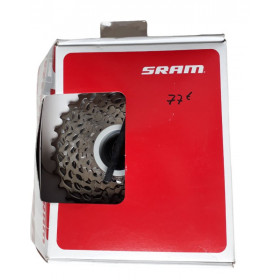-
 New product -35%Sram X7 PG1050 cassette 10s 11-32
New product -35%Sram X7 PG1050 cassette 10s 11-32- €55.24
- €84.99
Showing 1-1 of 1 item(s)
MTB 10-speed cassette: features and specificities of this versatile transmission
The MTB 10-speed cassette is still a popular choice among many riders, whether they enjoy sporty trail rides or demanding mountain adventures. At the heart of the drivetrain, it plays a crucial role in smooth gear shifting and efficient pedaling. Let’s take a closer look at its characteristics, advantages, and what to consider when choosing your cassette.
What is a 10-speed MTB cassette ?
The cassette is the set of sprockets mounted on the freehub body of the rear wheel. Combined with the chain, chainring, and rear derailleur, it forms the backbone of the drivetrain.
An MTB 10-speed cassette provides 10 different gears, allowing the rider to adapt their pedaling to the terrain: steep climbs, fast descents, or rolling trails.
Features of a 10-speed MTB cassette
-
Gear range: typically offered in ratios such as 11-36T, 11-40T, or even 11-42T for more demanding riding styles.
-
Compatibility: fits most standard Shimano/SRAM freehub bodies (excluding Micro Spline or XD, which are specific to 11- and 12-speed systems).
-
Weight and materials: usually made of steel for durability, sometimes combined with aluminum or titanium sprockets to save weight.
-
Versatility: works with both 2x10 drivetrains (two chainrings up front) and increasingly popular 1x10 setups.
Advantages of a 10-speed MTB cassette
-
Proven reliability: 10-speed drivetrains have stood the test of time for durability and ease of maintenance.
-
Wide availability: replacement parts, chains, and derailleurs for 10-speed systems remain easy to find and affordable.
-
Versatility: suitable for leisure MTB, cross-country, and even light enduro.
-
Easy maintenance: cleaning is straightforward, and replacing worn sprockets is more cost-effective compared to 11- or 12-speed cassettes.
When should you replace your MTB 10-speed cassette ?
A worn cassette often results in chain skipping and poor shifting precision. It’s best to replace it once the sprocket teeth show visible rounding or when a new chain no longer meshes properly. On average, a well-maintained cassette can last for several thousand kilometers.
Conclusion
The MTB cassette remains a solid and efficient option for most riders. With its balance of versatility, affordable price, and reliability, it is still a smart choice for equipping your bike. Whether you ride through forests, rocky trails, or mountain terrain, it ensures smooth drivetrain performance and consistent pedaling suited to your riding style.